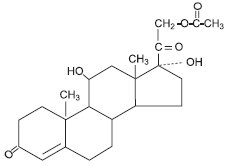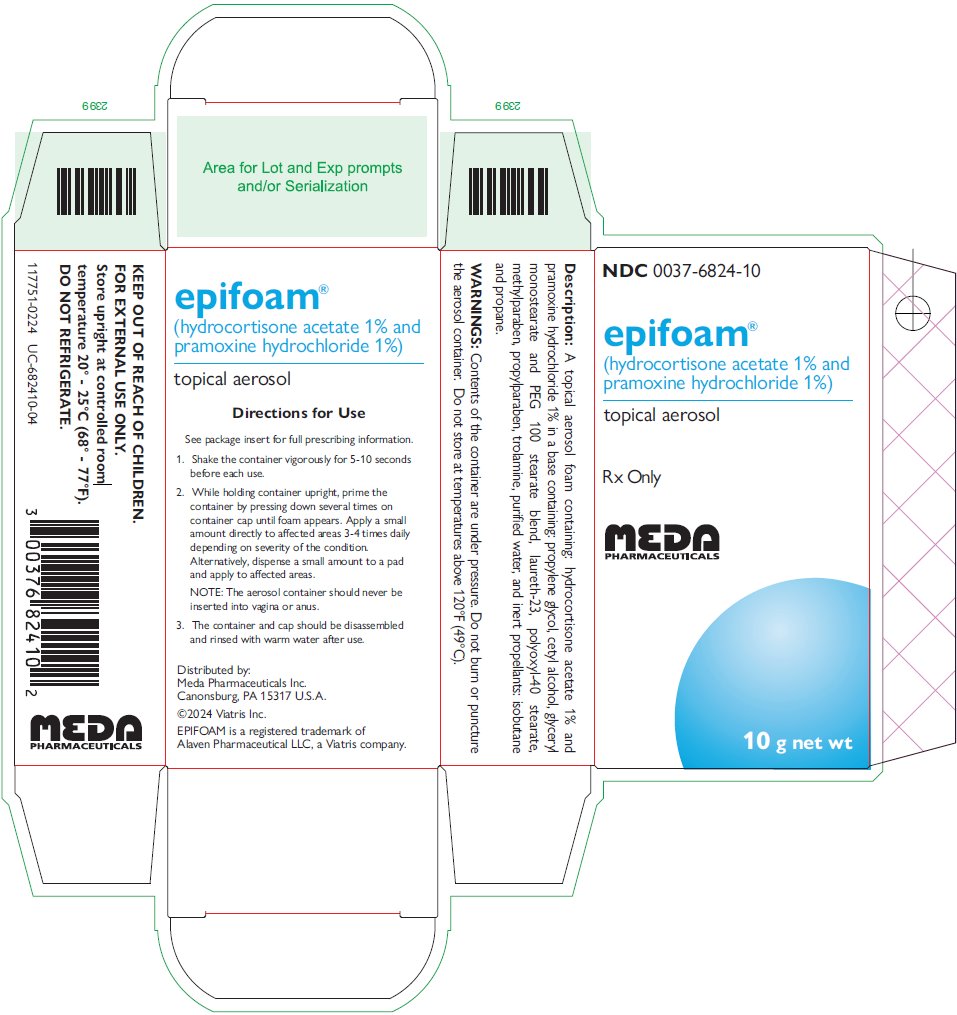Epifoam
Generic name: Pramoxine and Hydrocortisone Foam
Drug class: Anorectal preparations
Medically reviewed by A Ras MD.
What is Epifoam?
Epifoam is a prescription medicine that is used to treat skin irritation.
Description
Epifoam® (hydrocortisone acetate 1% and pramoxine hydrochloride 1%) is a topical aerosol foam containing: hydrocortisone acetate 1% and pramoxine hydrochloride 1% in a base containing: propylene glycol, cetyl alcohol, glyceryl monostearate and PEG 100 stearate blend, laureth-23, polyoxyl-40 stearate, methylparaben, propylparaben, trolamine, purified water and inert propellants: isobutane and propane.
Epifoam® contains a synthetic corticosteroid used as an anti-inflammatory/antipruritic agent and a local anesthetic.
Hydrocortisone acetate
Molecular weight: 404.50. Solubility of hydrocortisone acetate in water: 1mg/100mL.
Chemical name: Pregn-4-ene-3, 20-dione, 21-(acetyloxy)-11, 17-dihydroxy-(11β)-.

Pramoxine hydrochloride
Molecular weight: 329.86. Pramoxine hydrochloride is freely soluble in water.
Chemical name: morpholine, 4-[3-(4- butoxyphenoxy) propyl]-, hydrochloride.

Before taking Epifoam, tell your doctor:
- If you are allergic to Epifoam; any part of this medicine; or any other drugs, foods, or substances. Tell your doctor about the allergy and what signs you had.
This medicine may interact with other drugs or health problems.
Tell your doctor and pharmacist about all of your drugs (prescription or OTC, natural products, vitamins) and health problems. You must check to make sure that it is safe for you to take Epifoam with all of your drugs and health problems. Do not start, stop, or change the dose of any drug without checking with your doctor.
What are some things I need to know or do while I take Epifoam?
- Tell all of your health care providers that you take Epifoam. This includes your doctors, nurses, pharmacists, and dentists.
- Do not use longer than you have been told by the doctor.
- Use with care in children. Talk with the doctor.
- This medicine may affect growth in children and teens in some cases. They may need regular growth checks. Talk with the doctor.
- Talk with your doctor before you use other drugs or products on your skin.
- Do not put on cuts, scrapes, or damaged skin.
- Use care when using on a large part of the skin. Talk with the doctor.
- Tell your doctor if you are pregnant, plan on getting pregnant, or are breast-feeding. You will need to talk about the benefits and risks to you and the baby.
How is Epifoam best taken?
Use Epifoam as ordered by your doctor. Read all information given to you. Follow all instructions closely.
- Do not take Epifoam by mouth. Use on your skin only. Keep out of your mouth, nose, and eyes (may burn).
- Wash your hands before and after use. Do not wash your hands after use if putting this on your hand.
- Do not use coverings (bandages, dressings, make-up) unless told to do so by the doctor.
- Clean affected part before use. Make sure to dry well.
- Put a thin layer on the affected skin and rub in gently.
- Do not use tight-fitting diapers or plastic pants if treated part is in the diaper area. This may cause more drug to get into the body.
- Shake well before use.
- Hold upright to use. Do not turn upside down.
What do I do if I miss a dose?
- Use a missed dose as soon as you think about it.
- If it is close to the time for your next dose, skip the missed dose and go back to your normal time.
- Do not use 2 doses at the same time or extra doses.
What are the side effects of Epifoam that I need to call my doctor about immediately?
WARNING/CAUTION: Even though it may be rare, some people may have very bad and sometimes deadly side effects when taking a drug. Tell your doctor or get medical help right away if you have any of the following signs or symptoms that may be related to a very bad side effect:
- Signs of an allergic reaction, like rash; hives; itching; red, swollen, blistered, or peeling skin with or without fever; wheezing; tightness in the chest or throat; trouble breathing, swallowing, or talking; unusual hoarseness; or swelling of the mouth, face, lips, tongue, or throat.
- Signs of a weak adrenal gland like a very bad upset stomach or throwing up, very bad dizziness or passing out, muscle weakness, feeling very tired, mood changes, not hungry, or weight loss.
- Signs of Cushing’s disease like weight gain in the upper back or belly, moon face, very bad headache, or slow healing.
- Signs of high blood sugar like confusion, feeling sleepy, more thirst, more hungry, passing urine more often, flushing, fast breathing, or breath that smells like fruit.
- Irritation where Epifoam is used.
- Skin changes (pimples, stretch marks, slow healing, hair growth).
- Thinning of the skin.
What are some other side effects of Epifoam?
All drugs may cause side effects. However, many people have no side effects or only have minor side effects. Call your doctor or get medical help if any of these side effects or any other side effects bother you or do not go away:
- Dry skin.
- Burning.
- Itching.
These are not all of the side effects that may occur. If you have questions about side effects, call your doctor. Call your doctor for medical advice about side effects.
You may report side effects to the FDA at 1-800-332-1088. You may also report side effects at https://www.fda.gov/medwatch.
If overdose is suspected:
If you think there has been an overdose, call your poison control center or get medical care right away. Be ready to tell or show what was taken, how much, and when it happened.
How do I store and/or throw out Epifoam?
- Store at room temperature. Do not freeze.
- Store upright with the cap on.
- Protect from heat or open flame. Do not puncture or burn even if it seems empty.
- Keep all drugs in a safe place. Keep all drugs out of the reach of children and pets.
- Throw away unused or expired drugs. Do not flush down a toilet or pour down a drain unless you are told to do so. Check with your pharmacist if you have questions about the best way to throw out drugs. There may be drug take-back programs in your area.
Label
PRINCIPAL DISPLAY PANEL
- NDC 0037-6824-10
- epifoam®
- (hydrocortisone acetate 1% and
pramoxine hydrochloride 1%)
topical aerosol - Rx Only
- MEDA
- 10 g net wt

SRC: NLM .
